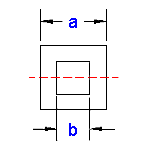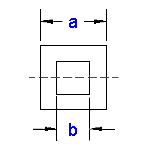|
|
A lurker on the list was kind enough to point me to the formula for
I for a square tube:
I =  
Looks like 1/8" wall 1.5"x1.5" square tubing will be adequate.
I = 0.2184
Maximum deflection at center:

5 * 450 * 120^3 / (384 * 30,000,000 * 0.2184) = 1.55".
At 110 mph wind pressure (30 lbs/sqft).
Supports spaced 1.5 ft apart = 450 pounds distributed load
over each 10 ft tube.
That should be more than acceptable.
Can anyone spot any error in these formulas or
calculations?
Finn
On 12/29/2010 12:46 AM, Finn Lassen wrote:
Looking to design and build hangar doors.
I kinda fancy vertical harmonica doors.
/\/\/\/\/\
The inner points carried by wheels in groove in concrete slab.
Wheels able to pivot in bottom of door frames.
Top supported by rollers in a steel U-channel, able to pivot in
top of door frames.
I figure 3 feet wide sections hinged at edges.
The thinner the better, but will have to be able to withstand wind
pressure without deforming.
10 feet tall.
Max wind pressure 31 pounds/sq ft. (110 mph wind zone).
Obviously that's on the high side. There are trees in the
vicinity. So 20 pounds/sq ft may be a more realistic number. But
it doesn't hurt to be on the safe side,
For calculations the vertical supports will be spaced 1.5 feet
apart. (Actually 3 feet apart but doubled at each edge).
I'm figuring maximum of 450 pounds of distributed weight (wind
pressure) on each vertical support.
I've seen a couple of different formulas for maximum deflection,
for example:
5/384 * W * L^3 / (E * I).
I assume I can safely use E = 30,000,000 for steel.
Let's say I'll allow 3" maximum deflection:
I = 0.113?
However, I'm having trouble arriving at values for I (area moment
of inertia).
What would I be for a 2"x2" 1/8" wall square steel tube?
(2 * 2^3) / 12 = 1.33?
Or would that only be for a solid 2x2" bar?
For a 1.5" square tube?
I = 0.42?
(I also need guard railing for my porch. Seems a1.5"D tube with
1/8" wall is I = 0.1276.

Does that seem right?)
Also, I guess I'm not so much concerned with deflection as with
point of permanent deformation.
How would I arrive at that number?
My objective is the thin hangar doors and the lightest guard
rails. And of course cheapest materials.
Sanity check appreciated.
Finn

sec4-moment-inertia.gif

section_square_case_4.gif

moz-screenshot-1.png


|
|